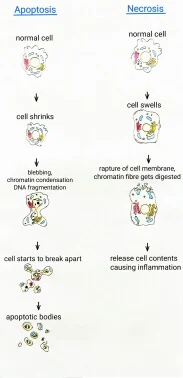Apoptosis and necrosis are they accelerate aging?
apoptosis
Apoptosis is programmed cell death. Apoptosis is a Greek word means “falling off”.In a multicellular organism if cells are no longer needed,or it’s DNA damaged and cannot be repaired,then the cells commits suicide by a process called programmed cell death or the Apoptosis. In human beings billions of cells die in bone marrow and intestine every hour .since 19th century scientists noticed and described about apoptosis but a clear definition was given by John Foxton Kerr at the university of Queensland in 1972.Later Hovitz,Sydney Brenner,and John E Samson identified the genes involved in apoptosis. In 2002 they got Nobel prize in medicine

In our body,cells are produced by cell multiplication (mitosis) and the apoptosis is used to the destruction of cells. Around 100,000 cells are produced in our body per second and approximately same number of cells die by apoptosis. Apoptosis generally used during embryonic stage to eliminate unwanted cells, for example the cells between fingers and toes are removed by apoptosis in embryonic stage. Half of the neurons that are created initially will die in later stages when adult brain is formed. Initiation of Apoptosis and it’s completion is within 2-3 hours, within this time period the cells also removed,so the researchers facing challenges to study much about this process
Apoptosis is initiated by caspases. Caspases are any of the family of intra cellular proteases , which are synthesized inside the cells. They are present in the cell as inactive precursors or procaspases. During apoptosis these inactive procaspases or precursors activated by proteolytic cleavage by another member of caspase family. There are two types of caspases,the initiator caspases and the effector caspases, the initiator caspases are caspase 2,8,9,10,11,12 and effector caspases are caspase 3,6,7. Internal and external stimuli can trigger apoptosis. There is two well known apoptosis pathways which are the intrinsic and extrinsic pathways. Both intrinsic and extrinsic pathways are doing the same work that activate the effector capsases (caspase 3,6,7).The only difference is that caspapase 9 used to activate effector caspase in intrinsic and caspase 8, used in extrinsic pathway.
Extrinsic pathway initiated when death inducing signalling complex formed in the cell surface. These formation happened when death ligard bonds with death receptors. Later the signalling complex force to cleave procaspase 8 and caspase 8 released to cystol. It act on effector caspases.
During apoptosis a cell undergone a series of changes,such as cell shrinkage, cytoplasm became dense,chromatin condensation (pyknosis),and DNA fragmentation (karyorrhexis).Irregular buds(blebbing) can be noticed on cell membrane, later membrane protrusions and finally the cell breaks apart into apoptosis bodies and adjacent phagocytic cells engulfed it
Necrosis
Necrosis is unplanned cell death,it may be due to lack of blood supply, infection, trauma,poison or any other reason. Necrosis starts with cell swelling,chromatin materials gets digested,loss of plasma membrane integrity, cell organelles broken down completely and finally, the cell lyses.
Aging and apoptosis
During aging it is noted that the size of muscular fibers are reduced and complete loss of some fibers. This condition his called sarcopenia. It is assumed that abnormal signaling of apoptosis and and mitochondrial dysfunction are the reason behind it,the exact reason remain obscure.
Aging and necrosis
Old mitochondria produce more oxidants than energy(ATP). Apoptosis is an energy depend mechanism,because of the deficiency of ATP in olden age apoptosis decreased and the necrosis mechanism increased. we know that necrosis not need any external energy. The bad effect of necrosis is that it release the product of cell death in an uncontrolled way in to the intracellular space,and resulting damages to the surrounding tissues.
Conclusion
In order to maintain physiological, immunological, and biochemical functions effectively in our body, creation of new cells and destruction of old and damaged cells are necessary. Apoptosis and Necrosis are involved in this purpose, but unregulated Apoptosis can hurt the entire body. In old age apoptosis causes several damage to brain, intestine, cardiovascular systems, prostate gland immune system etc. Increased programmed cell death has been observed in certain neurodegenerative diseases such as Huntington’s disease ,Parkinson’s disease,etc. many neural cells might die because of it’s action, unfortunately neural cells cannot undergo cell division( mitosis) .We don’t have much knowledge about the action of programmed cell death(PCD) in old age, in the mean time a number of researches going on, and this is an excellent subject for new researchers and one who looking for a Nobel prize.